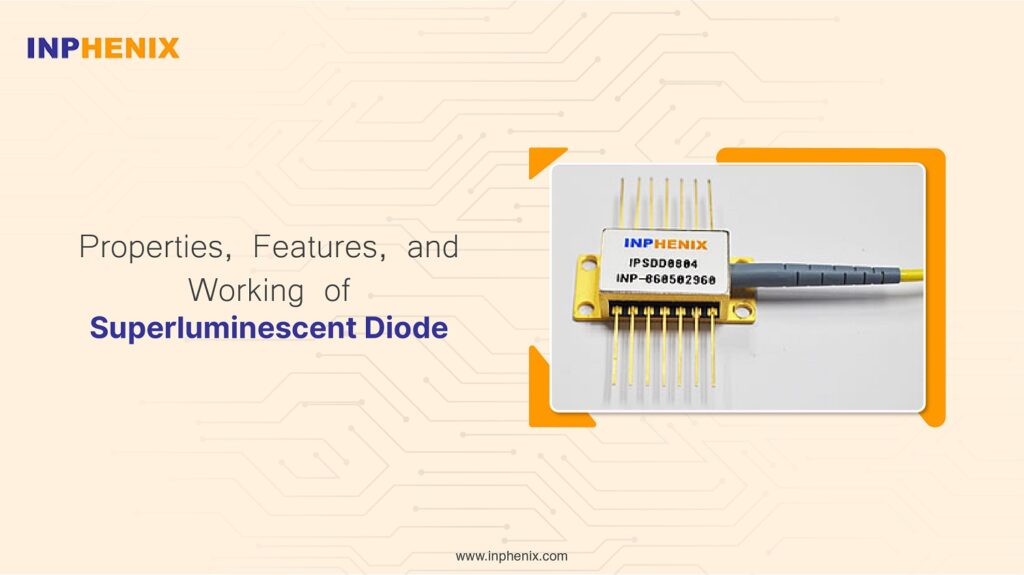
A superluminescent diode is a high-power LEDs that are built around a PN junction embedded in an optical waveguide. When electrically biased in the forward direction, they exhibit optical gain and generate amplified spontaneous emission over a wide range of wavelengths. An SLD light source has an output power similar to laser diode, the wide oscillation spectrum width of an LED (Light Emitting Diode), and low coherence.
Superluminescent diodes are a type of device that can bridge the gap between light-emitting diodes (LEDs) and laser diodes. A light generation method based on amplified spontaneous emission promotes the intense beam of the light source and the efficient use of light. Simultaneously, the light’s low time coherence reduces interference effects, which are undesirable in applications such as Optical Coherence Tomography.
In this blog, we see the definition, features, and properties of the SLD with its working method. So, let’s start with what a superluminescent diode is.

A superluminescent diode is a superluminescent edge-emitting semiconductor light source. It is a type of device that can combine the gap between light-emitting diodes (LEDs) and laser diodes.
Superluminescent laser diodes are designed to have high single-pass amplification for spontaneous emission generated along the waveguide, but unlike laser diodes, they do not have enough feedback to perform the lasing act.
SLDs were first developed in the arsenide material system in the early 1970s with the goal of developing an emitter that is coupled to an optical fiber and has low time coherence of the emitted light. The semiconductor emitters were made as a double-heterostructure type at the time, and the waveguide was made with an anti-reflection coating.
The revelation of the first nitride SLDs accelerated extensive research and rapid growth of the field fueled by the wide range of potential applications for which blue-violet SLD could be useful.
Let us now move on to the section on superluminescent diode properties.
1) Being a current-limiting device, its emitted optical power is proportional to the current. Unlike laser diodes, SLDs show a gradual increase in intensity with increasing current rather than a sharp increase.
2) Residual spectral modulation, which is caused by non-zero reflections from SLD facets and characterizes parasitic Fabry-Perot modulation.
3) The combination of laser-diode-like output power and brightness with a broad LED-like optical spectrum is what distinguishes superluminescent diodes.
4) SLD shows high sensitivity in external optical feedback because it has extremely high optical gain in its active region.
5) These diodes are emitters with perfect Antireflection Coatings (AR) on the chip facets, similar to laser diodes.
6) A Superluminescent Diode light source has an optical power comparable to a laser diode, and the wavelength of an SLD remains stable even in extreme temperatures and aging variations.
So these are 6 exceptional and distinct properties that make them ideal light sources for numerous applications. Let’s move on to the section on how superluminescent laser diodes work.
Like laser diodes, Superluminescent LEDs are focused on an electric drive p-n junction that becomes optically active and generates amplified emission over a broad wavelength range when biased in the forwarding direction. The wavelength and intensity of the SLED are determined by the composition of the active material as well as the injection current level. Single-pass amplification for spontaneous emission is generated along the waveguide to achieve lasting action.
An injection current is generated across the active region when an electrical forward voltage is applied. The electric current flow from the p-section through the active region to the n-section. Light is generated during this process by the spontaneous and random recombination of positive (holes) and negative (electrons) electrical carriers, which are then amplified as it travels along the waveguide of a SLED.
Let us now look at some of the most important features of a superluminescent laser diode.
So, these are some noticeable features and properties of the Superluminescent Diode with its working method.
We can conclude from this blog that, superluminescent laser diodes are one of the newest classes of nitride optoelectronic devices, and their development is gradually gaining momentum in the optoelectronic market. They are irreplaceable in certain applications that require a combination of good beam quality and low coherence due to their unique properties.
Inphenix is a company based in the United States that designs and manufactures lasers and light sources that are widely used in a variety of industries. Please contact us for more information.
